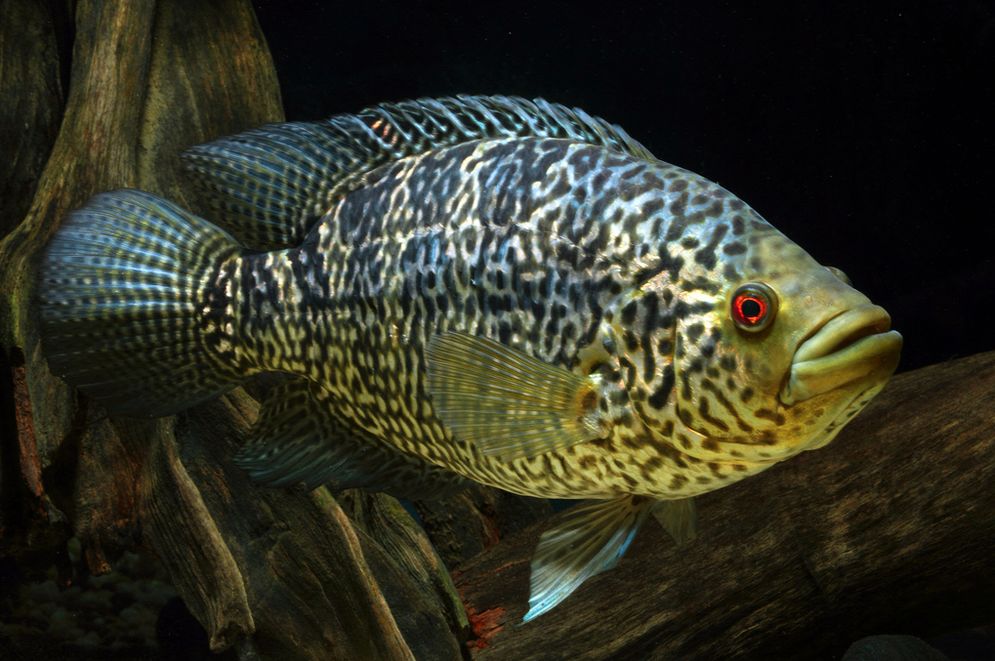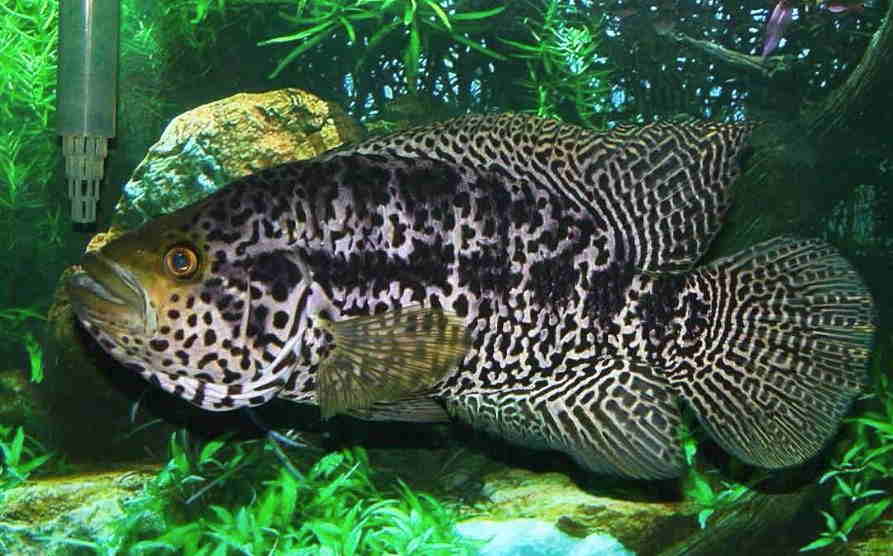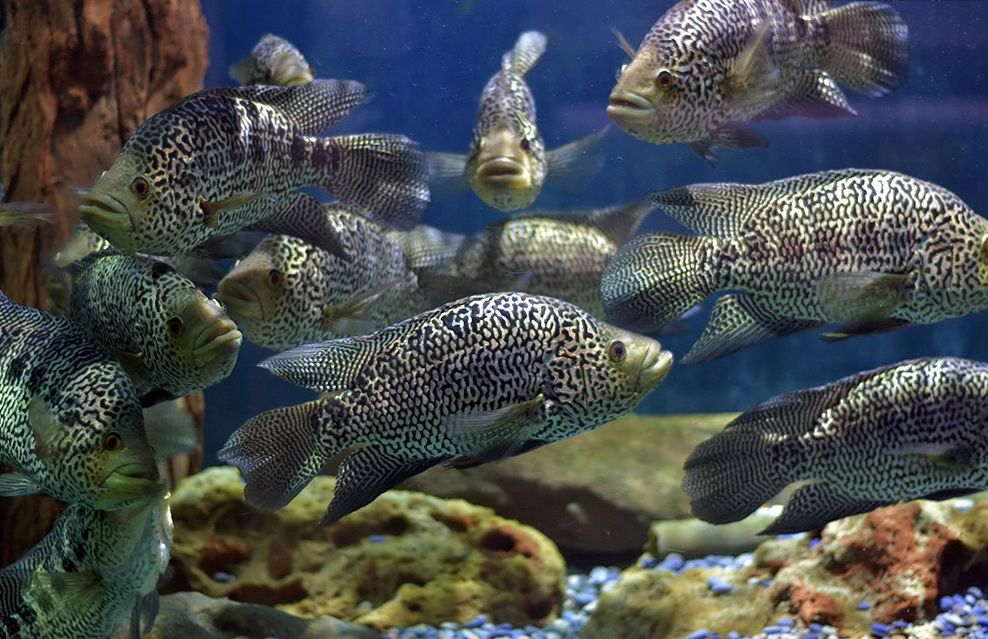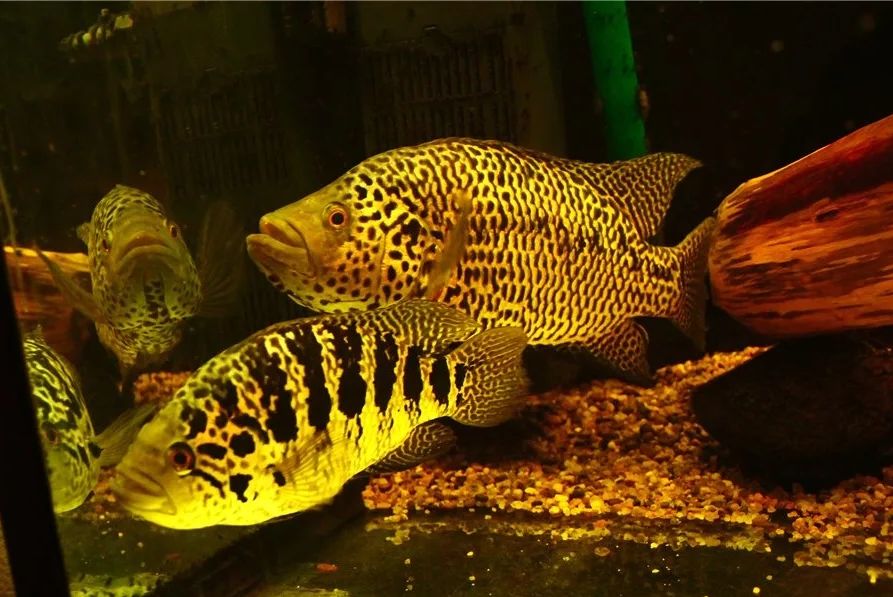Jaguar cichlid (Parachromis managuensis) is a large, raptorial, but very beautiful fish, and it is good for large cichlid fans. Unlike other cichlid, jaguar obtains the most of its color when it becomes reproductive. For example, the juveniles have noticeable black bands on their body and the mature fish becomes spotted, so due to these spots they got their “jaguar” name.

Contents
Habitat in the wild
The Jaguar Cichlid, scientifically known as Parachromis managuensis, belongs to the family Cichlidae. The Cichlidae family is a diverse group of freshwater fish that includes many popular aquarium species. They are known for their unique behaviors, striking colors, and complex social interactions.
Jaguar cichlid was first described by Gunther in 1867. Earlier the fish had the following names – Nandopsis managuense and Cichlasoma managuense.
In the wild, jaguar cichlids inhabit slow-moving rivers, ponds, and lakes in the Atlantic slope of Central America. They are often found in areas with dense vegetation, submerged tree roots, and rocky hiding spots along the shores. Nicaragua basins, namely Managua lake is where the fish comes from.
Now inhabits in the Lakes of Mexico, Panama, Guatemala, Singapore, Florida state (USA), Salvador since it was brought here by fisherman. This caused damage to local flora and fauna due to relatively unsociable temper and unrestrained gluttony of the fish. Although it inhabits in different waters from lakes with light ground and thickly covered with plants to fast rivers and tributaries. They tend to inhabit in warm waters where there’s usually little of dissolved oxygen.

Description
Body
Jaguar cichlid has an elongated, flat from sides and a bit oval body, which immediately shows that it is a raptorial feeder adapted to an aggressive assault.
Size
In the wild the jaguar cichlid max size is about 60 cm and it weighs about several kilos. In a tank size is a bit smaller – male size is about 40 cm and female – about 35 cm, however considering just these sizes allows to call this fish one of the largest cichlid that can be kept in amateurs’ tank.
Lifespan
Average jaguar cichlid lifespan is 15 years, but provided with good care it can live longer.
Color
Body is elongated, a bit flat from sides and it has a silvery background with spots of black or dark-brown color scattered on it. Due to these spots the fish got another common name reminding about a good looker in a cat family – spotted guapote cichlid. The pattern of spots on the body and their shape vary a lot.
It’s very difficult to find two fishes with the same pattern of body spots. The head is big with a large mouth and full lips. Jaguar cichlid has pharyngeal teeth to haunt and sharp “beams” on the fins to protect itself from other raptorial feeders.
| Characteristic | Description |
|---|---|
| Scientific Name | Parachromis managuensis |
| Common Names | Jaguar Cichlid, Managuense Cichlid, Aztec Cichlid |
| Origin | Central America (Nicaragua, Costa Rica) |
| Adult Size | Up to 14-16 inches (35-40 cm) |
| Lifespan | 10 to 15 years |
| Temperament | Aggressive, territorial |
| Aquarium Size | Minimum 75 gallons (284 liters) for a single adult |
| Water Temperature | 75°F to 82°F (24°C to 28°C) |
| Water pH | Slightly acidic to neutral (around 6.5 to 7.5) |
| Filtration | Strong and efficient filtration system required |
| Substrate | Fine sand or small gravel |
| Decorations | Caves, rocks, driftwood for hiding spots |
| Vegetation | Some hardy live plants can be added, but may be uprooted |
| Feeding | Carnivorous, primarily eats live or frozen meaty foods |
| Tank Mates | Keep with large, robust fish or in species-only setup |
| Breeding | Egg-layers, parental care for fry |
| Special Considerations | Requires experienced keepers, due to aggression |

Difficulties in keeping
Care isn’t difficult, if the necessity of having a big tank and powerful filters isn’t considered a a problem. Of course, this fish isn’t for beginners. It’s very large, aggressive and it’s a raptorial feeder.
Because of its size and aggressive temper it’s better to keep jaguar cichlid separately from other fishes in a biotope which is reminding it the basins of Central America and surely, one should avoid keeping in a tank with small and less aggressive fish as a tank mate.
Diet
Jaguar cichlid is a raptorial feeder.The fish feeds on everything that moves and that it can put into its mouth. It can be fed with small feeder fishes. During one meal one mature fish can consume up to 10 mature swordtails.
Here are some guidelines for feeding a jaguar cichlid in an aquarium:
- Live and frozen foods: The primary diet for jaguar cichlids should consist of live or frozen meaty foods. Jaguar cichlid can be fed with large blood worms, earthworms, prawns, large insects, small reptiles, frogs, meat farce, big flakes of dry feed, even mouse or big goldfish. These foods are rich in essential nutrients and help stimulate their natural hunting instincts.
- Commercial cichlid pellets: High-quality commercial cichlid pellets can also be included in their diet. Look for pellets specifically formulated for carnivorous cichlids, as they contain the necessary proteins and nutrients.
- Variety: Providing a varied diet is essential for the health of your Jaguar Cichlid. Rotating between different live, frozen, and pellet foods will help ensure they receive a balanced nutritional intake.
- Feeding frequency: Young Jaguar Cichlids can be fed multiple times a day, while adult specimens can be fed once or twice a day. Be careful not to overfeed, as this can lead to obesity and health issues.
- Monitor feeding behavior: Jaguar Cichlids are voracious eaters, and they can be aggressive during feeding. Ensure that all fish in the tank have an opportunity to eat by spreading the food across different areas of the tank.
- Avoid inappropriate foods: Never feed your Jaguar Cichlid foods that are high in carbohydrates or fillers, as they have a strictly carnivorous diet and cannot properly digest plant-based foods.
- Consider feeding live prey sparingly: While live foods are an essential part of their diet, there is a risk of introducing parasites or diseases through live prey. Quarantining and properly inspecting live foods before feeding can help mitigate this risk.
Care and keeping in a tank
Tank decor
Large objects should be used for the tank design – rocks, snags and big grained gravel should be used as a bottom. Provide ample hiding spots and territories for your jaguar cichlids by using large rocks and caves. You can stack rocks to create caves and crevices where the fish can retreat and establish their territories. Make sure the rocks are stable to avoid any collapses.
Adding large pieces of driftwood can create additional hiding spots and break up the line of sight in the tank. It can also create interesting structures and add a natural feel to the setup. In larger tanks or if you plan to keep more than one jaguar cichlid, using dividers or visual barriers made of acrylic or plastic can help create separate territories and reduce aggression.
Plants
There’s no need to put plants into a tank since these monsters will destroy them rather quickly and mercilessly. You can still include some hardy and well-rooted plants. Anubias, Java Fern, and Amazon Sword plants are good options, as they are more resistant to the cichlids’ activity.
Substrate
All cichlid are bottom diggers. Jaguar cichlid isn’t an exception, since it also likes to move the rocks around the tank bottom. Its size helps it a lot in this task. Avoid using fine decorations or small gravel that the cichlids could accidentally ingest, leading to health issues. Sand is preferred as it allows them to sift through it, mimicking their behavior in the wild.
Water parameters
Here are the recommended water parameters for these fish:
- Temperature: In the areas of their natural habitat the water temperature changes from 15 to 30°C. Some authors mention that jaguar fish can stand a short temperature decrease up to 12 °C. Nevertheless, we don’t advise you to test it. Jaguar Cichlids prefer a water temperature between 75°F to 82°F (24°C to 28°C). Keeping the water within this range mimics their natural habitat in Central America and supports their overall health and metabolism. It was noticed that the higher the temperature is, the more aggressive cichlid becomes. So, it’s better to keep water temperature on it’s lower limit 24 °C to decrease the fish aggressiveness.
- pH Level: The pH level should ideally be slightly acidic to neutral, ranging from 6.5 to 7.5. This range ensures that the water is not too alkaline or too acidic for the fish.
- Water Hardness: Jaguar cichlids can adapt to a range of water hardness levels. Aim for a moderate water hardness, with a general hardness (GH) between 8 to 12 dGH and a carbonate hardness (KH) between 6 to 12 dKH.
- Ammonia, Nitrite, and Nitrate: Ammonia and nitrite should always be kept at zero, as they are toxic to fish. Regular water testing is essential to monitor these parameters, especially during the initial cycling phase of the aquarium. Nitrate levels should be kept below 20-40 ppm through regular water changes.
- Water Filtration: Efficient filtration is essential for removing waste and maintaining water quality. Ample biological filtration is particularly important as it helps break down harmful ammonia and nitrite into less toxic nitrate.
- Water Changes: Regular water changes are crucial for diluting accumulated toxins and maintaining stable water parameters. Aim for weekly water changes of around 20-25% of the tank volume.
Tank size
The tank size for a jaguar cichlid largely depends on the age and size of the fish. Jaguar cichlids can grow quite large and are known for their aggressive behavior, so providing them with adequate space is essential for their well-being. Jaguar cichlids are very aggressive and to decrease their aggressiveness they need to have their own territory.
Here are some guidelines for tank size based on the age and growth stage of the fish:
- Juveniles: When jaguar cichlids are still young and relatively small (up to about 4 inches or 10 centimeters), you can start with a tank size of around 50 gallons (approximately 189 liters). This size will allow them some room to swim and grow.
- Subadults: As they grow larger (between 4 to 8 inches or 10 to 20 centimeters), you should consider moving them to a larger tank. A tank size of 75 gallons (around 284 liters) would be more appropriate for subadult jaguar cichlids.
- Adults: Adult cichlids can reach sizes of 12 to 16 inches (30 to 40 centimeters) or even larger. For a fully-grown adult, you will need a significantly larger tank of at least 125 gallons (around 473 liters) or more. Some enthusiasts recommend even larger tanks, such as 150 gallons (approximately 567 liters) or greater, to give these territorial and aggressive fish ample swimming space and to accommodate their size.
Keep in mind that these are general guidelines, and providing the largest possible tank within your available space and budget is always beneficial for the well-being of your fish. Larger tanks also help dilute aggression and make it easier to maintain water quality.
Tank mates
Tank mates can be other large cichlid fish from Central America or large catfish – redtail catfish, pleco, sailfin pleco. Giant gourami and pacu will also do.
It’s decidedly not the fish for community tanks. Since it’s an aggressive, territory-dependent fish and raptorial feeder which becomes even more aggressive during its spawning period. It’s generally not recommended to keep them with small or peaceful fish, as they may become targets for aggression or even seen as potential prey.
However, if you have a very large tank and want to attempt tank mates, consider the following guidelines:
- Large, robust cichlids: If you have a massive aquarium, you can try keeping jaguar cichlids with other large, aggressive cichlid species from Central and South America (oscar, green terror, Jack Dempsey, convict cichlid). However, even in this scenario, it’s essential to monitor the interactions carefully, as aggression and territorial disputes can still occur.
- Fast-moving fish: These are fast-moving, robust fish that can help distract the jaguar cichlid and reduce aggression. Large, active species like Silver Dollars (Metynnis species) or larger Barbs could serve as dither fish.
- Other large, predatory fish: In very large and well-maintained setups, you could consider keeping them with other large, predatory fish, like large catfish species (redtail catfish) or some species of Arowanas. However, ensure these species have similar water requirements and are not small enough to be seen as prey.
- Species-only tank: The safest option for Jaguar Cichlids is to keep them in a species-only tank. This way, you avoid potential conflicts and ensure the well-being of both your Jaguar Cichlid and any other fish you may want to keep separately. In a tank you can keep either one jaguar cichlid or a couple. They are rather aggressive to the fish of their kind unless fishes grew together. If male is given an unfamiliar female, it can kill her rather quickly, especially if he exceeds her in size.
Always have a backup plan and be prepared to remove tank mates if aggression becomes an issue. Remember, jaguar cichlids are known for their territorial and aggressive behavior, and they should be housed with caution and consideration for their specific needs.
Gender differences: male vs female
Distinguishing between male and female jaguar cichlids can be challenging, especially when they are young or not yet sexually mature. However, there are some general characteristics and behaviors that may help identify the differences:
- Size: In general, male tend to grow larger than females. As they mature, males can reach a size of 14 to 16 inches (35 to 40 cm), while females usually stay slightly smaller, around 10 to 12 inches (25 to 30 cm).
- Coloration: Mature male often display more vibrant and intense colors compared to females. They may have more extended and pronounced patterns and markings on their bodies, especially during breeding periods when their colors intensify.
- Egg spots: Males may develop small, round, white spots on their anal fin, known as “egg spots.” These spots serve a purpose during breeding, as they mimic the appearance of eggs, attracting females to the spawning site.
- Behavior: During breeding, males become more territorial and aggressive. They may exhibit increased aggression towards other fish, including females. Females, on the other hand, may display a more defensive behavior when guarding their eggs and fry.
- Genital papilla: Determining the sex of Jaguar Cichlids is more definitive when they are mature and ready to breed. At this stage, males will have a pointed genital papilla, which is a small, fleshy protuberance near the vent (anus). In contrast, females will have a more rounded and less pointed papilla.
- Body shape: In some cases, males might have a more elongated and streamlined body compared to the slightly rounder body shape of females.
Keep in mind that these differences may not be readily apparent until the fish reach sexual maturity, which can take several months or even years. Additionally, individual variations can occur, making it more challenging to determine the sex of juvenile or immature jaguar cichlids. If you want to be certain about the sex of your fish, it’s best to observe their behavior during breeding or seek the advice of an experienced cichlid breeder or veterinarian.

Breeding
Jaguar cichlids can breed in a community tank, but for the sake of everyone’s peace it’d be more desirable to provide them with separate territory (about 300 liters capacity tank) for their spawning period.
The fishes form a stable couple and they are brilliant parents. However, to create such a couple it’s required to raise together several juveniles to let them choose their match themselves.
The thing is that the idea of putting a mature female into a tank with a male quite often ends up with injuries or even death of the female. The male is very aggressive and even a stable couple should be kept in a spacious tank so the female will have a place to hide.
Water temperature should be raised a bit and kept on the level of 28 degrees. If the fish didn’t start breeding when it was expected it can be stimulated by changing the 25% of tank water with fresh defecated water of the same temperature.
After jaguar cichlid finds the place it lakes, the couple cleans it and designs the place as they like. The female can put the eggs on large flat stone, flowerpot, large snag. The female can lay about 5000 of big yellowish transparent eggs at one time.
The incubation period is about 2-3 days. After the juveniles appear they should be fed with small food (baby brine shrimp and daphnia). As juveniles grow they should be fed with more saturated and large grained feed.
Their growth pattern is cyclic. During the 1st two month the juveniles can grow up to 15 cm in size. And then they may need a year or a year and a half to reach the size of a mature fish.
The jaguar cichlid juveniles grow with a different speed, so the fish of different size can be seen among the juveniles from the same spawning period. Therefore to prevent cannibalism among the juveniles they should be sorted by size from time to time and put into different tanks according to their size.